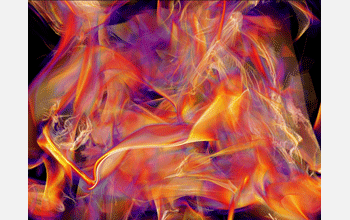Multimedia Gallery
Simulation showing distribution of entropy in developing Mach 1 turbulence
This simulation shows the distribution of entropy in developing Mach 1 turbulence. The white regions show where the earlier passage of strong shock fronts has heated the gas in this turbulent flow. This visualization system and simulation data were used to develop, test and validate theoretical models of turbulence for use in simulations in astrophysics and other areas of science and engineering.
[This visualization was created at the Laboratory for Computational Science and Engineering at the University of Minnesota. Work at the LCSE has been supported by a series of NSF equipment grants, most recently grant CNS 0708822. The visualization and data analysis leading to this image and the theoretical model of turbulence arising from it were carried out under support of an NSF Major Research Instrumentation grant.] (Date of Image: 2005)
Credit: Paul Woodward, Laboratory for Computational Science and Engineering, University of Minnesota
See other images like this on your iPhone or iPad download NSF Science Zone on the Apple App Store.
Images and other media in the National Science Foundation Multimedia Gallery are available for use in print and electronic material by NSF employees, members of the media, university staff, teachers and the general public. All media in the gallery are intended for personal, educational and nonprofit/non-commercial use only.
Images credited to the National Science Foundation, a federal agency, are in the public domain. The images were created by employees of the United States Government as part of their official duties or prepared by contractors as "works for hire" for NSF. You may freely use NSF-credited images and, at your discretion, credit NSF with a "Courtesy: National Science Foundation" notation.
Additional information about general usage can be found in Conditions.
Also Available:
Download the high-resolution JPG version of the image. (829 KB)
Use your mouse to right-click (Mac users may need to Ctrl-click) the link above and choose the option that will save the file or target to your computer.

